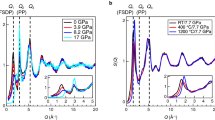Abstract
IT is well known that silicon carbide forms a great variety of polytypes. The significance of these polytypes is so far not fully understood, although the known types appear to be consistent with the theory postulated by Ramsdell and Kohn1 according to which : “Each polymer is characterised by a particular temperature stability range. At a given characteristic temperature a single type of polymer would produce a ‘pure type’ …. If stability ranges overlap two polymers might exist simultaneously resulting in a ‘mixed type’”.
This is a preview of subscription content, access via your institution
Access options
Subscribe to this journal
Receive 51 print issues and online access
$199.00 per year
only $3.90 per issue
Buy this article
- Purchase on Springer Link
- Instant access to full article PDF
Prices may be subject to local taxes which are calculated during checkout
Similar content being viewed by others
References
Ramsdell, L. S., and Kohn, J. A., Acta Cryst., 5, 215 (1952).
Author information
Authors and Affiliations
Rights and permissions
About this article
Cite this article
JEFFERY, J., MURTY, T. X-Ray Analysis of Parallel Growth and Disorder in Silicon Carbide Crystals. Nature 193, 1172–1173 (1962). https://doi.org/10.1038/1931172c0
Issue Date:
DOI: https://doi.org/10.1038/1931172c0
Comments
By submitting a comment you agree to abide by our Terms and Community Guidelines. If you find something abusive or that does not comply with our terms or guidelines please flag it as inappropriate.



